|
It’s been a year
since I wrote the last AWARE newsletter. We’ve posted many of
our updates on Facebook but for those of you that don’t use
Facebook, I apologise for the lack of communication in the
interim. At the time of last writing things were looking pretty
bleak for AWARE’s continued sustainability. The end of November
last year also saw the departure of our beloved dog Matsumi,
after a 9 month degenerative illness. She was our best friend,
having gifted Keith and me with 15¹/₂ years of unparalleled joy
and devotion, and coming to terms with this devastating loss
contributed to a huge sense of despondency and disillusionment
in our lives. Fortunately for AWARE, at about that time Tracey
Hugill joined the team as a fundraiser, and this year she has
really pulled the organization through its darkest hours into
the light of what promises to be a very bright future. Tracey
gave up her own corporate career to follow her heart and give
something back to the wildlife of Zimbabwe, and we are
extremely lucky to have found someone so passionate about the
cause. She works tirelessly harassing corporate and individual
sponsors, and putting on spectacular events, such as the Rhino
AWAREness Day at Raintree Lodge, a Rhino Golf Day at Borrowdale
Brooke Golf Club, and latterly we had the privilege of being
able to run and mountain bike with rhinos at Lake Chivero in a
sporting event to commemorate World Rhino Day in partnership
with PWMA.
Donkey
Clinics:
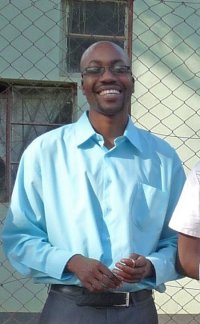 In another stroke of good fortune for AWARE and for
Zimbabwe’s donkeys, SPANA (The Society for the Protection of
Animals Abroad) – who has repeatedly evaluated our donkey
clinics by sending out several of their own donkey specialist
vets – pledged continued support to the donkey programme for a
minimum of 5 years. They have taken the decision to make
Zimbabwe a ‘SPANA core country’ through AWARE, and expand the
area covered in Zimbabwe by hiring a second veterinarian to
perform additional donkey clinics. And so we welcome Dr Andy
Garura to the team, and wish him a long and successful position
at AWARE.Andy and Erick travelled to Ethiopia earlier this
month to attend SPANA’s regional Continuing Education meeting
to keep abreast of the latest techniques in donkey
medicine. In another stroke of good fortune for AWARE and for
Zimbabwe’s donkeys, SPANA (The Society for the Protection of
Animals Abroad) – who has repeatedly evaluated our donkey
clinics by sending out several of their own donkey specialist
vets – pledged continued support to the donkey programme for a
minimum of 5 years. They have taken the decision to make
Zimbabwe a ‘SPANA core country’ through AWARE, and expand the
area covered in Zimbabwe by hiring a second veterinarian to
perform additional donkey clinics. And so we welcome Dr Andy
Garura to the team, and wish him a long and successful position
at AWARE.Andy and Erick travelled to Ethiopia earlier this
month to attend SPANA’s regional Continuing Education meeting
to keep abreast of the latest techniques in donkey
medicine.
SPANA intends to start up a working animal welfare
education programme, from school children all the way up to
vets and animal health inspectors in partnership with the Vet
Department, the University of Zimbabwe (UZ) and certain
technical colleges. The SPANA Education Director Diana Hulme
recently came to Zimbabwe to engage with our Ministry of
Education officials. In the pipeline for next year is also a
very exciting animal welfare community development scheme.
Meanwhile Erick is keeping up the good work and has treated
3008 donkeys so far this year, with a host of different disease
conditions. Pictures of the clinics can be found on our
facebook page:
https://www.facebook.com/pages/Aware-Trust-Zimbabwe/208441509209247.
Rhinos:
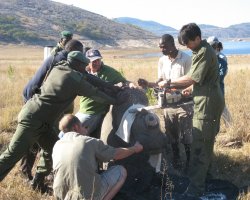 AWARE has continued
its monitoring and re-dehorning activities in partnership with
3 of Zimbabwe’s National Parks. We firmly believe that
comprehensive dehorning in these 3 areas is contributing to
keeping these rhino populations alive. Six white rhino were
re-dehorned as they had last been done in 2010, and one was ear
notched for identification purposes. We have had to postpone a
second dehorning exercise due to the lack of availability of a
helicopter within the suitable cool weather time frame.
In May, we welcomed the birth of a little white rhino male, a
calf for Katrina at Chivero. The camera trap study is still
ongoing and the game in the study area appears to be increasing
thanks to good Area Management – we even managed to catch a
brown hyaena on camera! We have also provided logistical
support in some of these areas, such as the purchase of a new
water tank, pipes, and through donations have supplied toys and
educational computers to the National Parks schools in these
areas. AWARE has continued
its monitoring and re-dehorning activities in partnership with
3 of Zimbabwe’s National Parks. We firmly believe that
comprehensive dehorning in these 3 areas is contributing to
keeping these rhino populations alive. Six white rhino were
re-dehorned as they had last been done in 2010, and one was ear
notched for identification purposes. We have had to postpone a
second dehorning exercise due to the lack of availability of a
helicopter within the suitable cool weather time frame.
In May, we welcomed the birth of a little white rhino male, a
calf for Katrina at Chivero. The camera trap study is still
ongoing and the game in the study area appears to be increasing
thanks to good Area Management – we even managed to catch a
brown hyaena on camera! We have also provided logistical
support in some of these areas, such as the purchase of a new
water tank, pipes, and through donations have supplied toys and
educational computers to the National Parks schools in these
areas.
Captive Lions:
 AWARE does
not support the breeding of lions in captivity. In July this
year, AWARE re-contracepted all the female captive lionesses at
the property in Masvingo. Despite the fact that last year we
decided to suspend further free treatment at this facility, we
could not stand the thought of more cubs being born, so we were
extremely grateful when Virbac (Australia) donated more
contraceptive implants. With the fences in disrepair, a male
lion had gone on a killing spree and had killed several
lionesses. One lioness had escaped and was killing goats
on the adjacent property. We spent a night parked next to a
village kraal waiting on one of the goat carcasses as bait to
try and lure her back so we could dart her and replace her in
the enclosures. She did not show up that night and sadly, the
following night, due to pressure from the community, a
professional hunter was called in to shoot her before we could
take up our positions. The next morning the killer male had
slain another female. We were asked by one of the stakeholders
to euthanase him, but we could not get permission from all the
stakeholders at the time. Allegedly this male has since been
put down. AWARE does
not support the breeding of lions in captivity. In July this
year, AWARE re-contracepted all the female captive lionesses at
the property in Masvingo. Despite the fact that last year we
decided to suspend further free treatment at this facility, we
could not stand the thought of more cubs being born, so we were
extremely grateful when Virbac (Australia) donated more
contraceptive implants. With the fences in disrepair, a male
lion had gone on a killing spree and had killed several
lionesses. One lioness had escaped and was killing goats
on the adjacent property. We spent a night parked next to a
village kraal waiting on one of the goat carcasses as bait to
try and lure her back so we could dart her and replace her in
the enclosures. She did not show up that night and sadly, the
following night, due to pressure from the community, a
professional hunter was called in to shoot her before we could
take up our positions. The next morning the killer male had
slain another female. We were asked by one of the stakeholders
to euthanase him, but we could not get permission from all the
stakeholders at the time. Allegedly this male has since been
put down.
We also contracepted 10 lionesses at Chipangali Wildlife
Sanctuary at the cost price of the immobilization drugs, and
another 6 at Lion and Cheetah Park, as well as vasectomising 2
males at the latter.
Capacity Building:
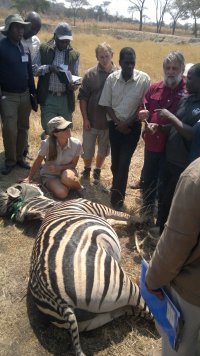 Having
attended the Malilangwe Drugs Course in February 2013 (a legal
requirement for keeping valid Dangerous Drugs Licences), Keith
and I felt that this Continuing Education should be financially
accessible for all veterinarians working in the field in
Zimbabwe. So it was an opportunity when Dr Norman Mukarati from
the University of Zimbabwe approached us and asked us to
partner with him and the Wildlife Veterinary Unit in organizing
a modestly priced wildlife course specifically targeting
working vets in the country. In addition to training in the
chemical and physical immobilisation of wildlife, the 23 vets
who attended (which included vets from Botswana and Zambia) had
2 days of wildlife disease lectures, and in-depth legislation
and welfare lectures. AWARE facilitated the lecturing by
esteemed wildlife veterinarians Dr Roy Bengis and Dr Cobus
Raath. Dr Roy Bengis worked as the Chief State Vet in Kruger
National Park for over forty years, and has won numerous awards
for his contributions to the veterinary profession. Dr Cobus
Raath was the head vet of Kruger’s capture team for over 10
years. He now owns Wildlife Pharmaceuticals, a company which
develops drugs used in game capture, as well as his own
wildlife consulting company. He runs similar courses in South
Africa and has trained over 1000 vets from 120 different
countries. Wildlife Pharmaceuticals co-sponsored the course,
and we are extremely grateful to them. We are also grateful to
the Lion and Cheetah Park who hosted the practical sessions. We
look forward to making this successful course an annual
event. Having
attended the Malilangwe Drugs Course in February 2013 (a legal
requirement for keeping valid Dangerous Drugs Licences), Keith
and I felt that this Continuing Education should be financially
accessible for all veterinarians working in the field in
Zimbabwe. So it was an opportunity when Dr Norman Mukarati from
the University of Zimbabwe approached us and asked us to
partner with him and the Wildlife Veterinary Unit in organizing
a modestly priced wildlife course specifically targeting
working vets in the country. In addition to training in the
chemical and physical immobilisation of wildlife, the 23 vets
who attended (which included vets from Botswana and Zambia) had
2 days of wildlife disease lectures, and in-depth legislation
and welfare lectures. AWARE facilitated the lecturing by
esteemed wildlife veterinarians Dr Roy Bengis and Dr Cobus
Raath. Dr Roy Bengis worked as the Chief State Vet in Kruger
National Park for over forty years, and has won numerous awards
for his contributions to the veterinary profession. Dr Cobus
Raath was the head vet of Kruger’s capture team for over 10
years. He now owns Wildlife Pharmaceuticals, a company which
develops drugs used in game capture, as well as his own
wildlife consulting company. He runs similar courses in South
Africa and has trained over 1000 vets from 120 different
countries. Wildlife Pharmaceuticals co-sponsored the course,
and we are extremely grateful to them. We are also grateful to
the Lion and Cheetah Park who hosted the practical sessions. We
look forward to making this successful course an annual
event.
In July we hosted 6 very enthusiastic veterinary students
from the UK and USA who had come to learn about wildlife work
(and donkey work) on 2 and 3 week veterinary placements. UZ
fifth year veterinary students have meanwhile been accompanying
Erick on some of his donkey clinics to get some much needed
equine experience in.
Research:
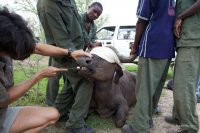 In December 2012, AWARE Trust won a SADC Transboundary
Animal Disease (TAD) Programme tender to perform disease
surveillance in buffalo in Mana Pools (which is part of the
Mana Pools- Lower Zambezi Trans Frontier Conservation Area), as
well as in cattle in the adjacent communal area. The buffalo
were mass captured in a boma and 26 were safely sampled for
foot and mouth disease, trypanosomiasis, and bovine
tuberculosis. The results are not yet available but are
expected to provide guidance for policy makers in the
region. In December 2012, AWARE Trust won a SADC Transboundary
Animal Disease (TAD) Programme tender to perform disease
surveillance in buffalo in Mana Pools (which is part of the
Mana Pools- Lower Zambezi Trans Frontier Conservation Area), as
well as in cattle in the adjacent communal area. The buffalo
were mass captured in a boma and 26 were safely sampled for
foot and mouth disease, trypanosomiasis, and bovine
tuberculosis. The results are not yet available but are
expected to provide guidance for policy makers in the
region.
Rehabilitation:
There has been the usual trickle of rehab cases. A bushpig
that ran into Harare suburbs and was under attack from a group
of local residents was darted and trans-located to a nearby
game park. An elephant in Kariba that had a deep penetrating
wound on his left hind leg was immobilized and X-rayed – a
small piece of wood was removed from the wound, and he was
treated with antibiotics after determining there was no
fracture. On a second trip to Kariba at the request of KAWFT,
we were after a young male elephant with a terrible snare wound
of about 4 years duration. (He has been treated twice by other
people, but it looks as though there is still some wire left in
the leg, and at the very least it needs to be X-rayed). Cavan
located a maternal herd shortly after dawn, and adrenaline was
on a high as Keith and Andries crept through the thick jesse
after the agitated females in order to put a dart in.
Unfortunately we realized we were following the wrong herd and
after spending a further futile 2 days there searching for the
right herd, we returned to Harare and are still waiting for him
to be sighted again. Anton meanwhile rescued yet another 2
stray zebras at separate times - one from Mufakose and one from
the main Bulawayo Road. A male ostrich at Mukuvisi Woodlands
received treatment for a deep laceration in his neck, which had
opened up his oesophagus allowing food to fall through his neck
when he ate. A duiker that was attacked by dogs had to be
euthanased as she had sustained severe ligament damage and
fractures to both hind limbs. Her tiny orphaned fawn Bella is
now growing up at Wild is Life. 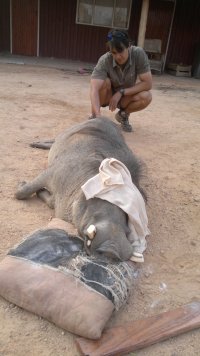
I don’t normally mention private work in AWARE’s newsletters
but we had an interesting case at Pamuzinda, where Spike, an
increasingly aggressive resident warthog faced the death
penalty for killing the owner’s dog, and being a potential
danger to people – unless we could trim his tusks to a size
where he could not do any damage. Fortunately, we were able to
Xray his tusks to see exactly where the pulp cavity ended, and
trimmed off his ivory just beyond that, thus buying him a few
more years of sleeping by the fire in the lodge’s
restaurant.
Environment:
We have become increasingly alarmed about the appalling air
quality in the last few months, not only in Harare, but
countrywide as Zimbabweans appear to have become a nation of
pyromaniacs. We have good environmental laws in place, and in
fact setting veld fires was criminalized earlier this year, but
enforcement is poor. Every second garden regularly sends up a
massive bonfire causing a thick layer of particulate matter
which hangs over Harare, which together with generator fumes
from the 15 hour power cuts which have plagued us since the
elections, are causing a host of respiratory problems. Lisa was
invited to do a presentation for the City of Harare Waste
Management Meeting on the health risks associated with burning
organic matter and leaves. Following this we have been tasked
by some members of the public to set up an environmental branch
of AWARE to be more pro-active in environmental issues. We
started by printing out 1000 pamphlets in English and Shona
about the health hazards of burning and distributed this to
households in Harare’s suburbs. We made these pamphlets
available in electronic form to the general public and other
organizations. We are currently looking for the funding to
purchase an air quality (particulate matter) reader so that we
can start issuing daily air quality reports and warning the
public when exercising outdoors, etc. is hazardous. We also
intend to engage the police, EMA and other authorities to set
up a bike-mounted patrol to fine burners and polluters within
the city limits.
Thanks:
Our support base has really picked up thanks to Tracey’s
hard work, and we hugely appreciate the fact that the
Zimbabwean (and international) public is willing to do so much
for conservation. Space constraints in this letter mean that I
will publish a list of supporters shortly on our facebook page,
but you know who you are – THANK YOU!!!!
Please support the Debby Hart exhibition this Friday – the
door proceeds are going to AWARE!
|